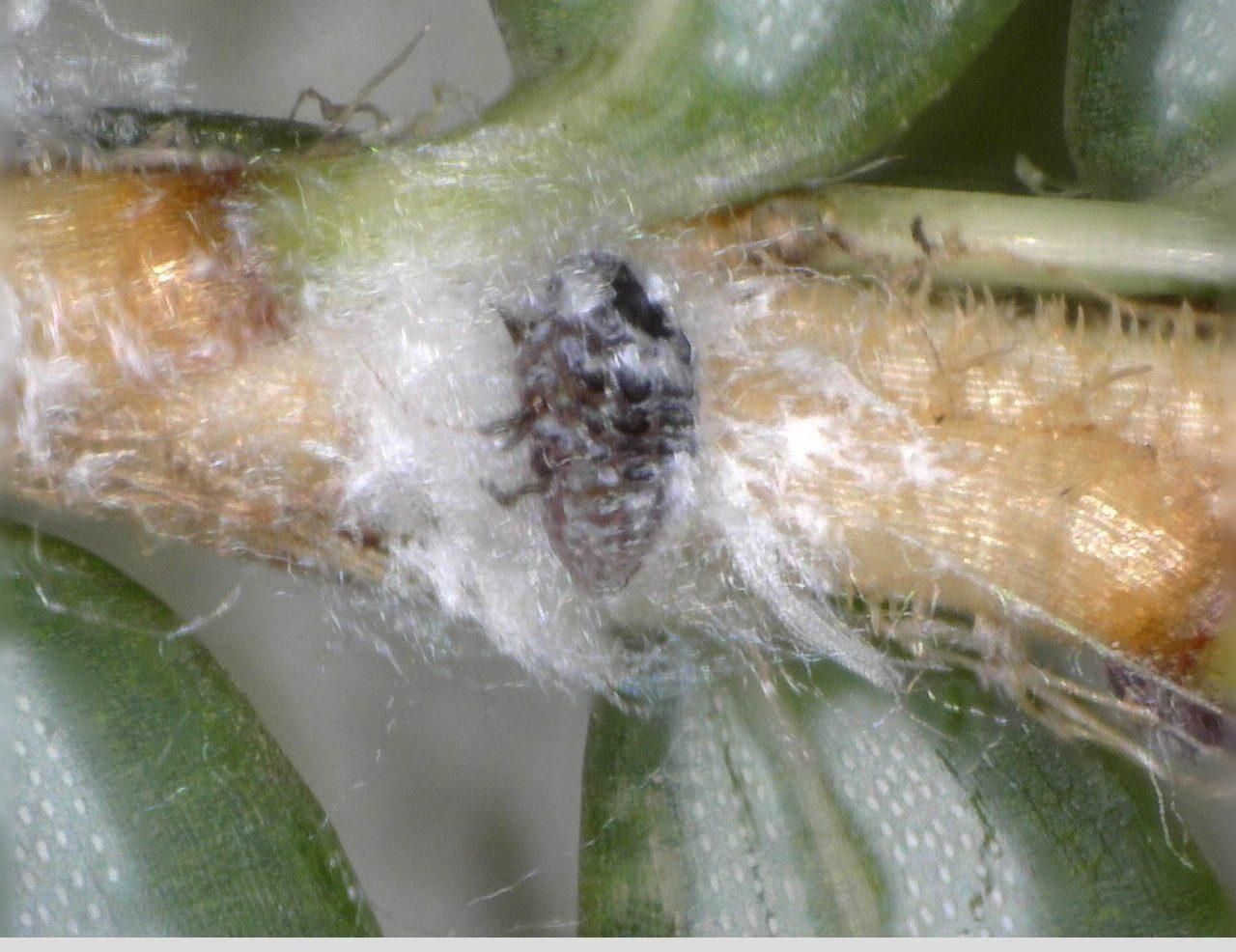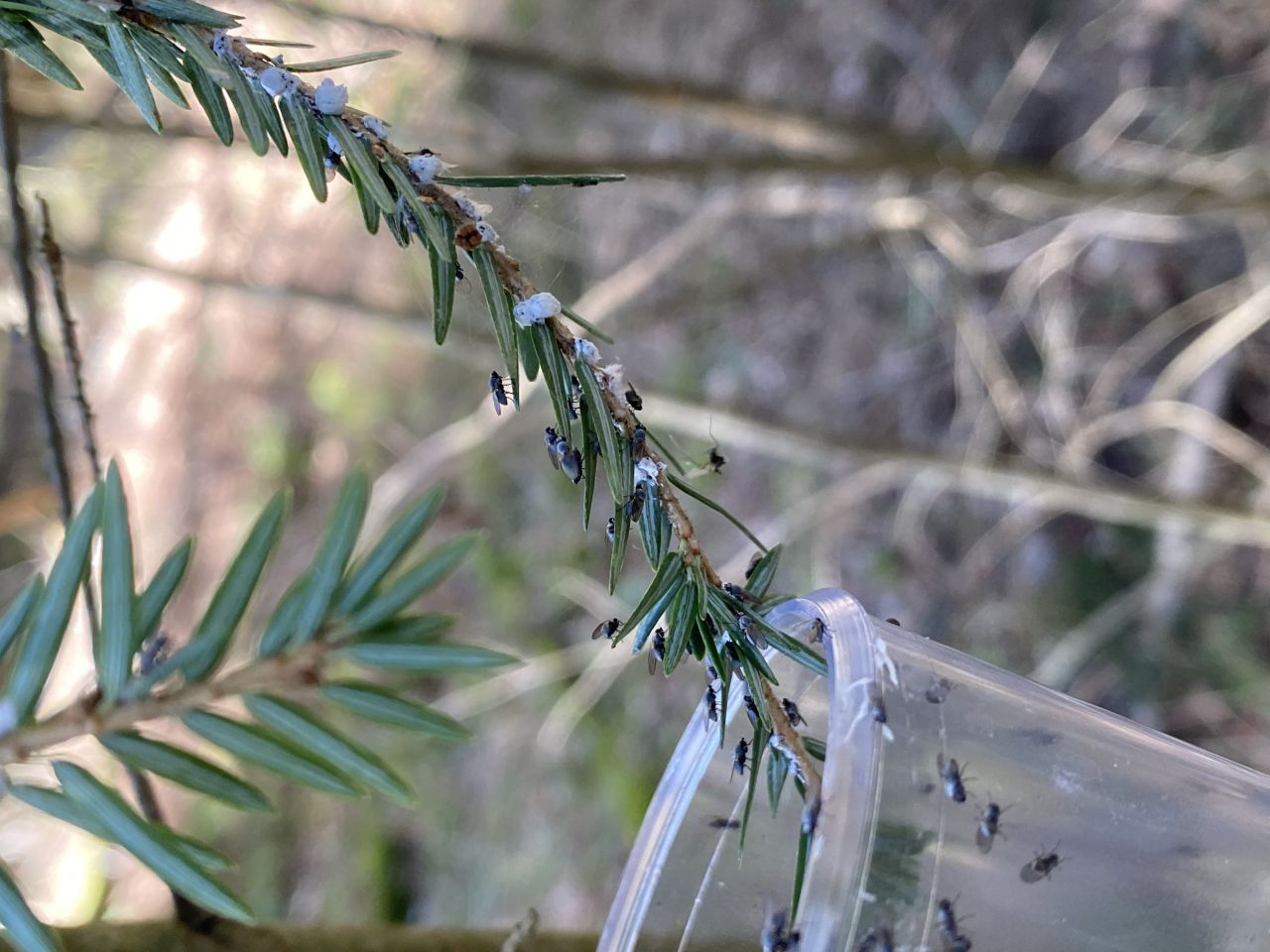Environmental DNA –Tracking down hemlock woolly adelgids and other invasive species
Exotic species invading new ecosystems can wreak havoc on native environments. In the battle against these pests, environmental DNA has emerged as a valuable tool for detecting infestations and enabling timely, effective interventions.

A close-up photo of a hemlock tree infested by hemlock woolly adelgids. When white woolly structures are visible, it may be too late to save the trees. Image: Adobe Stock
Profile
- The adult hemlock woolly adelgid (HWA) is tiny, measuring around 1 mm in length.
- It is oval in shape and brown in color.
- It has four thread-like stylets*, bundled as a mouthpart, which are three times its body length and used to pierce host plants for nutrition.
- HWA egg sacs look like small cotton tufts at the underside of host tree branches.
Classification
- Kingdom
- Animalia
- Phylum
- Arthropoda
- Class
- Insecta
- Order
- Hemiptera
- Family
- Adelgidae
- Genus
- Adelges
- Species
- A. tsugae
What is the problem?
The tiny hemlock woolly adelgid (HWA) is threatening eastern hemlock, a large tree abundantly distributed throughout Eastern North America. HWA was accidentally introduced into North America from Asia. It feeds on the nodes from which the needle-like hemlock leaves emerge, disrupting nutrient flow and eventually killing these towering giants, often within 4 to 10 years.
What makes HWA so deadly?
The HWA was introduced only about 100 years ago to the eastern US, and the native eastern hemlock tree populations have not yet developed resistance mechanisms to fight this infestation. The insects are so small that they can be transported by wind or they can hitch a ride on birds ensuring a widespread dispersal. Their reproductive strategy compounds the problem: they reproduce asexually laying eggs that produce genetically identical clones. A single HWA individual can start a new population of thousands of individuals. To make matters worse, HWA have no natural predators in Eastern North America to control their population growth and colonization.

Hemlock wooly adelgid at the base of hemlock needles. Image: © NYSHI
What can we do about it?
First, we need to be able to detect HWA early. The sooner we identify an infestation, the higher the impact of management measures. Once identified, an Integrated Pest Management strategy including insecticide application and biological control can be implemented. Systemic* insecticides are important tools in the management strategy against HWA, however, they are expensive and difficult to deploy over large, remote areas. Biological control involves the introduction of specialized predators to the infested areas where the introduced predators can then control the pest populations. These biological control predators were studied to ensure they specialize in eating only adelgids and are unlikely to have unintended impacts on the ecosystem. Four species, two beetles (Laricobius nigrinus and Laricobius osakensis) and two silver flies (Leucotaraxis argenticollis and Leucotaraxis piniperda), are now being released as biological control for HWA. Biological control releases are currently underway in multiple US states by organizations in universities as well as government organizations such as USDA Forest Service. Once released, the predators need to be regularly monitored to evaluate their establishment.

Silver flies being released on hemlock trees infested with hemlock woolly adelgids. Image: © NYSHI
Early detection of HWA with molecular tools
While HWA can easily be spotted due to their characteristic white woolly secretions, searching for and identifying the early stages of HWA infestations correctly is an extremely laborious process. It’s like finding a needle in a haystack; there may be only a few individuals in a large forest stand during the early stages of infestation. However, environmental DNA (eDNA) offers a revolutionary alternative!
eDNA is the term used to describe small fragments of DNA shed by organisms into their environment via dead skin cells, feces, mucus, etc. Researchers at The New York State Hemlock Initiative at Cornell University (NYSHI) have developed an eDNA-based tool that has improved HWA detection rates from 23% using traditional methods to 90% using eDNA based methods! The process involves rinsing hemlock twigs to wash off all eDNA, then filtering the rinse water to collect the genetic material. DNA is then extracted from the filters, and qPCR* (quantitative polymerase chain reaction) is used to detect HWA-specific DNA. The qPCR process, similar to COVID-19 PCR tests, enables early detection of infestations, increasing the chances of effective intervention. eDNA analysis is scalable and cost-efficient, making it ideal for surveying large forest areas.

Workflow for detecting HWA using eDNA analysis. Image: © Anish Kirtane
Beyond HWA, eDNA analysis can also be utilized to track other invasive species such as the spotted lanternfly and the brown marmorated stink bug or to monitor the establishment of released biological control predator beetles and silver flies. Advanced techniques like metabarcoding can identify entire groups of organisms such as fish, invertebrates, plants or even all metazoans, enabling comprehensive biodiversity assessments in a scalable and non-invasive manner.
Acknowledgments
Thanks to Dr. Tonya Bittner from NYSHI for providing useful comments on a draft of this article.
Glossary*
qPCR: A molecular biology technique that couples amplification and quantification of a target DNA sequence.
Stylet: A hard, sharp, needle-like mouthpart in certain insects, used for piercing plant or animal tissue to suck fluids.
Systemic insecticides: Insect-killing chemicals absorbed by plants and transported through their tissues, protecting them from pests that feed on them.
References
Kirtane A et al. 2022. Sensitive environmental DNA (eDNA) methods to detect hemlock woolly adelgid and its biological control predators Leucotaraxis silver flies and a Laricobius beetle. Environmental DNA, 4;5:1136-1149. https://onlinelibrary.wiley.com/doi/full/10.1002/edn3.317
